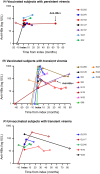Anti-HBc-nonreactive occult hepatitis B infections with HBV genotypes B and C in vaccinated immunocompetent adults
- PMID: 35876456
- PMCID: PMC9804389
- DOI: 10.1111/jvh.13733
Anti-HBc-nonreactive occult hepatitis B infections with HBV genotypes B and C in vaccinated immunocompetent adults
Abstract
Absence of anti-HBc reactivity with detectable anti-HBs was observed in blood donors with occult hepatitis B virus (HBV) infection (OBI). The prevalence and mechanisms underlying this uncommon condition were investigated over time in Chinese blood donors with OBI. Isolated anti-HBs OBI status was identified from 466,911 donors from Dalian, China, and monitored in follow-up (range: 2.6-84.3 months). HBV vaccination status was documented, and infecting viral strains were characterized. Of 451 confirmed OBIs (1:1035), 43 (9.5%; 1:10,858) had isolated anti-HBs as only serological marker. Isolated anti-HBs OBIs differed from anti-HBc-reactive OBIs by significantly younger age (median 24 years), higher HBV DNA (median: 20 IU/ml) and anti-HBs (median 60.5 IU/L) levels, paucity of mutations in HBV Core and S proteins, and high vaccination rate (72%). Vaccinated isolated anti-HBs OBIs (n = 31) differed from unvaccinated (n = 11) by significantly younger age (22 vs 38 years), higher anti-HBs level at index (48% vs 9% with anti-HBs >100 IU/L) and higher frequency of anti-HBs immune response (44% vs 20%). Of 15 vaccinated and 5 unvaccinated OBIs follow-up, 65% (8 vaccinated and 5 unvaccinated) became HBV DNA negative suggesting aborted recent infection, while 35% (7 vaccinated) had low persistent viraemia 2 to 65 months post index. In conclusion, isolated anti-HBs OBI in Chinese blood donors appears associated with young, vaccinated, adults exposed to HBV who predominantly develop low level aborted infection revealed by transient HBV DNA and immune anti-HBs response. However, a subset of individuals still experienced low but persistent viral replication whose clinical outcome remains uncertain.
Keywords: HBV variants; anti-HBs; blood donors; hepatitis B vaccine; hepatitis B virus; occult infection; viral DNA.
© 2022 The Authors. Journal of Viral Hepatitis published by John Wiley & Sons Ltd.
Conflict of interest statement
The authors declare no conflict of interest.
Figures



Similar articles
-
High prevalence of anti-hepatitis B core antigen in hepatitis B virus-vaccinated Chinese blood donors suggests insufficient protection but little threat to the blood supply.Transfusion. 2015 Apr;55(4):890-7. doi: 10.1111/trf.12902. Epub 2014 Nov 2. Transfusion. 2015. PMID: 25363504
-
Comparative analysis of hepatitis B virus infections in blood donors born before and after the implementation of universal HBV vaccination in southern China.Transfus Med. 2023 Feb;33(1):81-89. doi: 10.1111/tme.12903. Epub 2022 Aug 16. Transfus Med. 2023. PMID: 36815535
-
Hepatitis B Virus Chronic Infection in Blood Donors from Asian and African High or Medium Prevalence Areas: Comparison According to Sex.Viruses. 2022 Mar 24;14(4):673. doi: 10.3390/v14040673. Viruses. 2022. PMID: 35458403 Free PMC article.
-
Occult hepatitis B virus infection.Transfus Clin Biol. 2004 Feb;11(1):18-25. doi: 10.1016/j.tracli.2003.11.007. Transfus Clin Biol. 2004. PMID: 14980545 Review.
-
Occult hepatitis B virus infection: implications in transfusion.Vox Sang. 2004 Feb;86(2):83-91. doi: 10.1111/j.0042-9007.2004.00406.x. Vox Sang. 2004. PMID: 15023176 Review.
Cited by
-
Hepatitis B Vaccine: Four Decades on.Vaccines (Basel). 2024 Apr 18;12(4):439. doi: 10.3390/vaccines12040439. Vaccines (Basel). 2024. PMID: 38675820 Free PMC article. Review.
-
Insights on 21 Years of HBV Surveillance in Blood Donors in France.Viruses. 2022 Nov 12;14(11):2507. doi: 10.3390/v14112507. Viruses. 2022. PMID: 36423116 Free PMC article.
-
Re-Entry Evaluation of Chinese Blood Donors with Unconfirmed Hepatitis B Screening Results.Viruses. 2022 Nov 17;14(11):2545. doi: 10.3390/v14112545. Viruses. 2022. PMID: 36423154 Free PMC article. Review.
-
Establishing a screening strategy for non-discriminatory reactive blood donors by constructing a predictive model of hepatitis B virus infection status from a single blood center in China.Front Public Health. 2024 Mar 27;12:1366431. doi: 10.3389/fpubh.2024.1366431. eCollection 2024. Front Public Health. 2024. PMID: 38601498 Free PMC article.
-
Serological and Molecular Characterization of Occult HBV Infection in Blood Donors from South Italy.Viruses. 2023 Dec 31;16(1):71. doi: 10.3390/v16010071. Viruses. 2023. PMID: 38257771 Free PMC article.
References
-
- Raimondo G, Locarnini S, Pollicino T, et al. Update of the statements on biology and clinical impact of occult hepatitis B virus infection. J Hepatol. 2019;71:397‐408. - PubMed
-
- Lelie N, Bruhn R, Busch M, et al. Detection of different categories of hepatitis B virus (HBV) infection in a multi‐regional study comparing the clinical sensitivity of hepatitis B surface antigen and HBV‐DNA testing. Transfusion. 2017;57:24‐35. - PubMed
-
- Ni YH, Hsu HY, Chang MH, Chen DS, Lee CY. Absence or delayed appearance of hepatitis B core antibody in chronic hepatitis B surface antigen carrier children. J Hepatol. 1993;17:150‐154. - PubMed
-
- Zoulim F, Zhang X, Pichoud C, Trepo C. Heterogeneity of hepatitis B virus (HBV) core gene in a patient with HBV‐associated cirrhosis and serum negativity for anti‐HBc. J Hepatol. 1996;24:155‐160. - PubMed
-
- Kantelhardt VC, Schwarz A, Wend U, et al. Re‐evaluation of anti‐HBc non‐reactive serum samples from patients with persistent hepatitis B infection by immune precipitation with labelled HBV core antigen. J Clin Virol. 2009;46:124‐128. - PubMed
Publication types
MeSH terms
Substances
LinkOut - more resources
Full Text Sources
Medical

